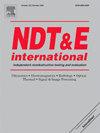Insensitive effect of crack length in non-electrically conductive materials on the displacement current field in electromagnetic induction testing
IF 4.5
2区 材料科学
Q1 MATERIALS SCIENCE, CHARACTERIZATION & TESTING
引用次数: 0
Abstract
Electromagnetic induction testing (EIT), an emerging extension of eddy current testing (ECT), has enabled the evaluation of non-electrically conductive materials by utilizing displacement currents generated by applying a high-frequency alternating current voltage. However, the fundamental detection mechanisms, particularly for crack characterization, remain inadequately understood. In this study, the effect of crack length on the displacement current field in EIT was investigated through finite element analysis (FEA) and experiments. FEA was performed to calculate eddy and displacement current fields in both electrically and non-electrically conductive materials with cracks of different lengths. The FEA results showed that the eddy current field changed significantly even for short crack lengths, whereas the displacement current field changed significantly only when the crack was positioned directly beneath the driver coil. In the experiments, different crack lengths were introduced into carbon fiber reinforced thermoplastics (CFRTPs) and glass fiber reinforced plastics (GFRPs), both exhibiting in-plane electrically isotropic properties detectable by EIT. In CFRTPs, cracks could be measured regardless of their length, whereas in GFRPs, they could be measured only when they extended beneath the probe. These findings indicate that the displacement current field in non-electrically conductive materials is relatively insensitive to crack length, highlighting the importance of probe positioning when EIT is performed. These insights can aid in optimizing non-destructive evaluation protocols for composite structures in various field applications.

电磁感应检测中非导电材料裂纹长度对位移电流场的不敏感效应
电磁感应测试(EIT)是涡流测试(ECT)的新兴延伸,它利用施加高频交流电电压产生的位移电流来评估非导电材料。然而,基本的检测机制,特别是裂纹表征,仍然没有充分了解。本文通过有限元分析和实验研究了裂纹长度对电致伸缩板位移电流场的影响。采用有限元法计算了具有不同长度裂纹的导电和非导电材料中的涡流和位移电流场。有限元分析结果表明,即使裂纹长度较短,涡流场也会发生显著变化,而位移电流场只有在裂纹位于驱动线圈正下方时才会发生显著变化。在实验中,碳纤维增强热塑性塑料(CFRTPs)和玻璃纤维增强塑料(GFRPs)引入了不同长度的裂纹,两者都表现出平面内电各向同性。在cfrps中,无论其长度如何,都可以测量裂缝,而在gfrp中,只有当裂缝延伸到探针下方时才能测量裂缝。这些发现表明,非导电材料中的位移电流场对裂纹长度相对不敏感,这突出了在进行EIT时探针定位的重要性。这些见解可以帮助优化各种现场应用中复合材料结构的无损评估方案。
本文章由计算机程序翻译,如有差异,请以英文原文为准。
求助全文
约1分钟内获得全文
求助全文
来源期刊

Ndt & E International
工程技术-材料科学:表征与测试
CiteScore
7.20
自引率
9.50%
发文量
121
审稿时长
55 days
期刊介绍:
NDT&E international publishes peer-reviewed results of original research and development in all categories of the fields of nondestructive testing and evaluation including ultrasonics, electromagnetics, radiography, optical and thermal methods. In addition to traditional NDE topics, the emerging technology area of inspection of civil structures and materials is also emphasized. The journal publishes original papers on research and development of new inspection techniques and methods, as well as on novel and innovative applications of established methods. Papers on NDE sensors and their applications both for inspection and process control, as well as papers describing novel NDE systems for structural health monitoring and their performance in industrial settings are also considered. Other regular features include international news, new equipment and a calendar of forthcoming worldwide meetings. This journal is listed in Current Contents.
 求助内容:
求助内容: 应助结果提醒方式:
应助结果提醒方式:


